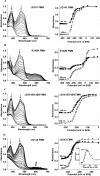Mutants of Cytochrome P450 Reductase Lacking Either Gly-141 or Gly-143 Destabilize Its FMN Semiquinone
- PMID: 27189945
- PMCID: PMC4938185
- DOI: 10.1074/jbc.M116.724625
Mutants of Cytochrome P450 Reductase Lacking Either Gly-141 or Gly-143 Destabilize Its FMN Semiquinone
Abstract
NADPH-cytochrome P450 oxidoreductase transfers electrons from NADPH to cytochromes P450 via its FAD and FMN. To understand the biochemical and structural basis of electron transfer from FMN-hydroquinone to its partners, three deletion mutants in a conserved loop near the FMN were characterized. Comparison of oxidized and reduced wild type and mutant structures reveals that the basis for the air stability of the neutral blue semiquinone is protonation of the flavin N5 and strong H-bond formation with the Gly-141 carbonyl. The ΔGly-143 protein had moderately decreased activity with cytochrome P450 and cytochrome c It formed a flexible loop, which transiently interacts with the flavin N5, resulting in the generation of both an unstable neutral blue semiquinone and hydroquinone. The ΔGly-141 and ΔG141/E142N mutants were inactive with cytochrome P450 but fully active in reducing cytochrome c In the ΔGly-141 mutants, the backbone amide of Glu/Asn-142 forms an H-bond to the N5 of the oxidized flavin, which leads to formation of an unstable red anionic semiquinone with a more negative potential than the hydroquinone. The semiquinone of ΔG141/E142N was slightly more stable than that of ΔGly-141, consistent with its crystallographically demonstrated more rigid loop. Nonetheless, both ΔGly-141 red semiquinones were less stable than those of the corresponding loop in cytochrome P450 BM3 and the neuronal NOS mutant (ΔGly-810). Our results indicate that the catalytic activity of cytochrome P450 oxidoreductase is a function of the length, sequence, and flexibility of the 140s loop and illustrate the sophisticated variety of biochemical mechanisms employed in fine-tuning its redox properties and function.
Keywords: cytochrome P45 oxidoreductase; cytochrome P450; diflavin oxidoreductase; electron transfer; flavoprotein; microsomal electron transport system; mutagenesis; oxidation-reduction (redox); redox potential.
© 2016 by The American Society for Biochemistry and Molecular Biology, Inc.
Figures













References
-
- Massey V., and Hemmerich P. (1980) Active-site probes of flavoproteins. Biochem. Soc. Trans. 8, 246–257 - PubMed
-
- Røhr A. K., Hersleth H.-P., and Andersson K. K. (2010) Tracking flavin conformations in protein crystal structures with Raman spectroscopy and QM/MM calculations. Angew. Chem. Int. Ed. Engl. 49, 2324–2327 - PubMed
-
- Miura R. (2001) Versatility and specificity in flavoenzymes: control mechanisms of flavin reactivity. Chem. Rec. 1, 183–194 - PubMed
Publication types
MeSH terms
Substances
Associated data
- Actions
- Actions
- Actions
- Actions
- Actions
- Actions
- Actions
- Actions
- Actions
- Actions
- Actions
- Actions
- Actions
- Actions
- Actions
- Actions
- Actions
Grants and funding
LinkOut - more resources
Full Text Sources
Other Literature Sources
Molecular Biology Databases

